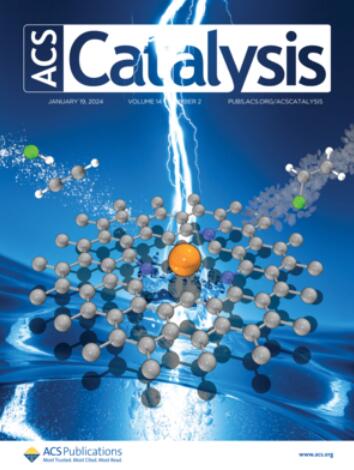Revisits the Selectivity toward C2+ Products for CO2 Electroreduction over Subnano-Copper Clusters Based on Structural Descriptors
IF 13.1
1区 化学
Q1 CHEMISTRY, PHYSICAL
引用次数: 0
Abstract
Subnanometal catalysts usually possess significant catalytic performance due to their unique ″finite size effect″. The nanoengineering of copper (Cu) catalysts is a crucial approach for CO2 electroreduction (CO2ER) toward multicarbon (C2+) products. However, whether subnano-Cu clusters (0.5–2 nm) are a forbidden or promising zone for C2+ products through CO2ER remains controversial. To shed light on the feasibility and potential of Cu subnanoclusters as catalysts for CO2ER toward C2+ products, we employ global optimization by Revised Particle Swarm Optimization algorithm, density functional theory calculations, and microkinetic modeling on a range of Cu subnanoclusters with varying sizes to investigate CO2ER reactivity. We propose a geometric–electronic composite structural descriptor that characterizes the reaction energies and construct a theoretical reaction rate contour map based on the structural descriptor. The contour map reveals that Cu sites, reaching an optimal balance between the C–C coupling energy barrier and coverage of the coupling precursor, tend to exhibit high C2H4 yield. Furthermore, a volcano-like trend is presented between the theoretical turnover frequency of C2H4 products and the size of subnanoclusters, which is experimentally validated. Notably, medium-sized Cu subnanoclusters (around 1 nm) possessing the highest proportion of edge sites with the optimal value of structural descriptor own superior C2H4 yield to the large particles or monocrystal Cu catalysts in experiments. This work represents the first theoretical confirmation regarding the feasibility of subnano-Cu clusters in CO2RR for C2+ production and provides insights into its underlying mechanisms. These findings expand the field in size-dependent reactivity of Cu catalysts toward C2+ products through CO2ER and provide guidance for designing efficient Cu electrocatalysts at the subnanoscale.

基于结构描述符的亚纳米铜簇对C2+产物的CO2电还原选择性研究
亚纳米金属催化剂由于其独特的″有限尺寸效应″,通常具有显著的催化性能。铜(Cu)催化剂的纳米工程是二氧化碳电还原多碳(C2+)产物的重要途径。然而,亚纳米cu团簇(0.5-2 nm)是C2+通过CO2ER生成产物的禁区还是有希望的区域仍然存在争议。为了阐明Cu亚纳米团簇作为C2+产物CO2ER催化剂的可行性和潜力,我们采用修正粒子群优化算法、密度泛函理论计算和微动力学建模对一系列不同尺寸的Cu亚纳米团簇进行全局优化,以研究CO2ER反应性。我们提出了一个表征反应能量的几何-电子复合结构描述符,并基于该结构描述符构建了理论反应速率等高线图。等高线图显示,Cu位点在C-C偶联能垒和偶联前驱体覆盖率之间达到最佳平衡,往往表现出较高的C2H4产率。此外,C2H4产物的理论周转频率与亚纳米团簇的大小之间存在类似火山的趋势,并得到了实验验证。值得注意的是,与大颗粒或单晶Cu催化剂相比,具有最高边缘位比例和最佳结构描述子值的中型Cu亚纳米团簇(约1 nm)具有更好的C2H4产率。该研究首次从理论上证实了CO2RR中亚纳米cu簇用于C2+生产的可行性,并提供了对其潜在机制的见解。这些发现拓展了Cu催化剂通过CO2ER对C2+产物反应性的研究领域,并为设计亚纳米级高效Cu电催化剂提供了指导。
本文章由计算机程序翻译,如有差异,请以英文原文为准。
求助全文
约1分钟内获得全文
求助全文
来源期刊

ACS Catalysis
CHEMISTRY, PHYSICAL-
CiteScore
20.80
自引率
6.20%
发文量
1253
审稿时长
1.5 months
期刊介绍:
ACS Catalysis is an esteemed journal that publishes original research in the fields of heterogeneous catalysis, molecular catalysis, and biocatalysis. It offers broad coverage across diverse areas such as life sciences, organometallics and synthesis, photochemistry and electrochemistry, drug discovery and synthesis, materials science, environmental protection, polymer discovery and synthesis, and energy and fuels.
The scope of the journal is to showcase innovative work in various aspects of catalysis. This includes new reactions and novel synthetic approaches utilizing known catalysts, the discovery or modification of new catalysts, elucidation of catalytic mechanisms through cutting-edge investigations, practical enhancements of existing processes, as well as conceptual advances in the field. Contributions to ACS Catalysis can encompass both experimental and theoretical research focused on catalytic molecules, macromolecules, and materials that exhibit catalytic turnover.
 求助内容:
求助内容: 应助结果提醒方式:
应助结果提醒方式:


